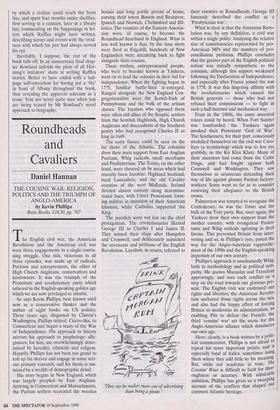Roundheads and Cavaliers
Daniel Hannan
THE COUSINS' WAR: RELIGION, POLITICS AND THE TRIUMPH OF ANGLO-AMERICA by Kevin Phillips Basic Books, £24.50, pp. 707 The English civil war, the American Revolution and the American civil war were three engagements in a single contin- uing struggle. One side, victorious in all three episodes, was made up of radicals, Puritans and entrepreneurs, the other of High Church Anglicans, conservatives and landowners. It was the triumph of the Protestant and revolutionary party which ushered in the English-speaking golden age which we are now privileged to inhabit.
So says Kevin Phillips, best known until now as a conservative thinker and the author of eight books on US politics. Three years ago, disgusted by Clinton's Washington, Phillips retired, Cicero-like, to Connecticut and began a study of the War of Independence. His approach to history mirrors his approach to psephology: alle- giances, for him, are overwhelmingly deter- mined by heredity, ethnicity and religion. Happily, Phillips has not been too grand to roll up his sleeves and engage in some seri- ous primary research, and his thesis is sus- tained by a wealth of demographic detail.
His story begins in New England, which was largely peopled by East Anglians. Arriving in Connecticut and Massachusetts, the Puritan settlers recreated the wooden houses and long public greens of home, naming their towns Boston and Braintree, Ipswich and Norwich, Chelmsford and Bil- lerica. The counties of the Eastern Associa- tion were, of course, to become the Roundhead heartland in England. What is less well known is that, by the time shots were fired at Edgehill, hundreds of New Englanders were streaming back to fight alongside their cousins.
These restless, entrepreneurial people, who were to become known as Yankees, went on to lead the colonies in their bid for independence. When the fighting began in 1775, familiar battle-lines re-emerged. Ranged alongside the New England Con- gregationalists were the Scotch-Irish of Pennsylvania and the bulk of the artisan classes. The loyalists who opposed them were often old allies of the Stuarts: settlers from the Scottish Highlands, High Church Anglicans and descendants of the Southern gentry who had recognised Charles II as king in 1649.
The same fissure could be seen on the far shore of the Atlantic. The colonists drew their main support from East Anglian Puritans, Whig radicals, small merchants and Presbyterians. The Tories, on the other hand, were cheered on by areas which had recently been Jacobite: Highland Scotland, rural Lancashire, and the old Cavalier counties of the west Midlands. Ireland divided almost entirely along denomina- tional lines, with Ulster Protestants form- ing militias in imitation of their American kinsmen, while Catholics supported the King.
The parallels were not lost on the chief protagonists. The revolutionaries likened George III to Charles I and James II. They named their ships after Hampden and Cromwell, and deliberately mimicked the covenants and petitions of the English Revolution. Loyalists, in return, referred to `They say he makes more out of advertising than being a pirate.' their enemies as Roundheads. George III famously described the conflict as a `Presbyterian war'.
What is clear is that the American Revo- lution was, by any definition, a civil war within a single polity. Analysing the relative size of constituencies represented by pro- American MPs and the numbers of pro- conciliation petitions, Phillips concludes that the greater part of the English political nation was initially sympathetic to the colonists, although this support weakened following the Declaration of Independence, and especially after France joined the war in 1778. It was this lingering affinity with the revolutionaries which caused the British generals — those who had not refused their commissions — to fight in such a half-hearted and mechanical way.
Even in the 1860s, the same ancestral voices could be heard. When Fort Sumter was bombarded, the Yankees again invoked their Protestant 'God of War'. The Southerners, for their part, consciously modelled themselves on the civil war Cava- liers (a terminology which was to live on, grubbily, in the Ku Klux Klan). Many of their ancestors had come from the Celtic fringe, and had fought against both Cromwell and Washington. They saw themselves as aristocrats defending their way of life against gloomy Puritan factory- workers. Some went so far as to consider renewing their allegiance to the British crown.
Palmerston was tempted to recognise the Confederacy, as was the Times and the bulk of the Tory party. But, once again, the Yankees drew their own support from the mother country, with evangelical Protes- tants and Whig radicals agitating in their favour. This prevented Britain from inter- vening and so, in Phillips's eyes, paved the way for the Anglo-American rapproche- ment of the 1890s and the English-speaking imperium of our own century. Phillips's approach is unashamedly Whig, both in methodology and in political sym- pathy. He quotes Macaulay and Trevelyan approvingly, and sees each conflict as a step on the road towards our glorious pre- sent. The English civil war enshrined our rights and liberties; the American Revolu- tion anchored those rights across the sea, and also had the happy effect of forcing Britain to modernise its administration, so enabling Pitt to defeat the French; the third 'cousins' war' set the scene for the Anglo-American alliance which dominates our own age. Here, clearly, is a book written by a polit- ical commentator. Phillips is not afraid to repeat his more important points, and is especially fond of italics, sometimes using them where they add little to his meaning. But, while not academic in tone, The Cousins' Wars is difficult to fault for thor- oughness or accuracy. With admirable ambition, Phillips has given us a sweeping account of the conflicts that shaped our common Atlantic heritage.


























































































 Previous page
Previous page